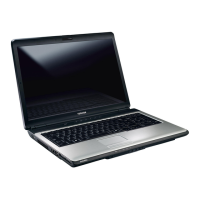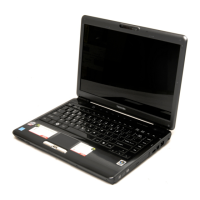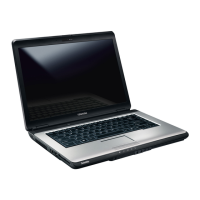
Do you have a question about the Toshiba Satellite L350 series and is the answer not in the manual?
| Optical Drive | DVD SuperMulti |
|---|---|
| Operating System | Windows Vista Home Premium |
| Battery | 6-cell Lithium-ion |
| Chipset | Mobile Intel GM965 Express Chipset |
| Wireless | 802.11b/g Wi-Fi |
| LAN | 10/100 Ethernet |
| Ports | 3x USB 2.0, VGA, HDMI, headphone/microphone jacks, Ethernet |
| Card Reader | 5-in-1 card reader (SD, MMC, Memory Stick, Memory Stick Pro, xD) |
Lists the items included with your computer for setup.
Identifies and describes the physical components of the computer.
Lists the pre-installed software applications and drivers for your computer.
Highlights unique and advanced features of the computer for enhanced usability.
Identifies front-side ports, controls, and indicators on the computer.
Identifies ports, vents, and slots located on the left side.
Identifies ports, security slots, and drives on the right side.
Explains the meaning of the computer's status indicator lights.
Details types, specifications, and supported formats of optical drives.
Guide to connecting the power adapter for charging or operation.
Procedures for powering the computer on, off, and managing modes.
Accessing and using system repair tools for troubleshooting.
Navigation and interaction with the touchpad for pointer control.
Instructions for loading, removing, and managing discs.
How to use the built-in webcam utility for capturing images and video.
Connecting, disconnecting, and configuring the internal modem.
Managing wireless network connections and settings.
Describes keys with programmed functions when pressed.
Explains using the FN key with other keys for special features.
Details keyboard shortcuts for quick access to system features.
Status of power sources and explanation of indicator lights.
Guidelines for battery handling, charging, and maintenance.
Step-by-step instructions for removing and installing a battery.
Explains Boot, Hibernation, and Sleep modes.
Configuring computer hardware parameters via the HW Setup utility.
Setting, resetting, and deleting computer user passwords.
Adjusting internal LCD and external monitor display options.
Instructions for installing and removing ExpressCards for expanded functionality.
Information on using SD, SDHC, MS, MS Pro, and MMC memory cards.
Guides for installing and removing memory modules to increase RAM.
How to connect and configure external monitors for display output.
Instructions for connecting external devices via HDMI for audio and video.
General guidelines for identifying and resolving computer issues effectively.
Basic checks to perform before diagnosing more complex computer problems.
Troubleshooting steps for specific computer components and peripherals.
Solutions for common issues related to power sources and battery.
Solutions for issues related to accessing or writing to CD/DVD/HD DVD drives.
Troubleshooting steps for modem and network connection problems.
Information on factors that may affect CPU performance.
Notes on memory allocation, battery performance, and replacement.
Factors affecting wireless LAN speed and LCD brightness.











